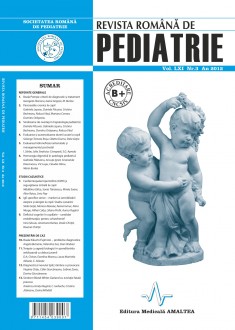SELECT ISSUE

Indexed

| |

|
|
|
| |
|
|
|

|
|
|
|
|
|
|
HIGHLIGHTS
National Awards “Science and Research”
NEW! RJP has announced the annually National Award for "Science and Research" for the best scientific articles published throughout the year in the official journal.
Read the Recommendations for the Conduct, Reporting, Editing, and Publication of Scholarly work in Medical Journals.
The published medical research literature is a global public good. Medical journal editors have a social responsibility to promote global health by publishing, whenever possible, research that furthers health worldwide.
Specific serum IgE – marker for atopic sensitization and allergy in children. Case study
Stela Gotia, Monica Alexoae, Ileana Ioniuc, Alina Murgu, Mihai Colţa, Liliana Profir and Aurica Rugina
ABSTRACT
Specific serum IgE elevated levels integrated in anamnesis and clinical context, make the diagnosis more precise and suggest the severity of the allergic diseases. Knowing the allergen could be predictive and is essential for the secondary prevention measures. Objective: determination of serum specific IgE in children of different ages with clinical manifestations of allergy, to assess the spectrum of allergens incriminated and their correlation with clinical diagnosis. Methods: retrospective study, 30 months (2007-2009) on 423 children diagnosed based on international criteria with different allergic diseases. Serum specific IgE was performed by a immunecromathographical quantitative assay QuantiScan. Results: Serum specific IgE values were positive in 71,39% cases (302 children) from all 423 children included in the study, more frequently in children under 6 years of age (61,25%). Polysensitizations were more frequently, especially to respiratory allergens, 66 children over 6 years (21,85%) and 43 young children (14,23%) and monosensitizations under 6 years old (Dermatophagoides 6,25% , cow’s milk - 5,62%). Respiratory allergy (bronchial asthma+/- allergic rhinitis) was correlated with polysensitizations, including also food allergens – 67%, more frequently in children over 6 years old. Atopic dermatitis was correlated mainly with food allergy (48%) in children under 3 years old. Incriminated allergens ( in order of frequency): cow’s milk, dermatophagoides, egg white, peanuts - under 6 years; dust, pollens, animal epithelia, peanuts – over 6 years old. Conclusions: specific serum IgE confirm the clinical diagnosis in most cases. Polysensitizations were detected in patients with systemic allergy symptoms. The allergens spectrum is characterised by the high frequency of polysensitizations and respiratory allergens sensitizations in young children.
Key words: specific IgE, allergy diseases, children
